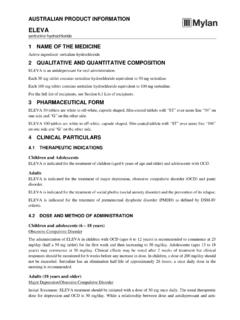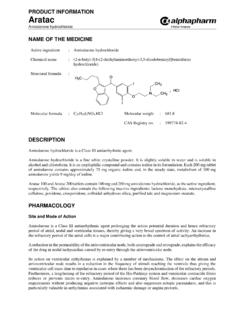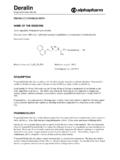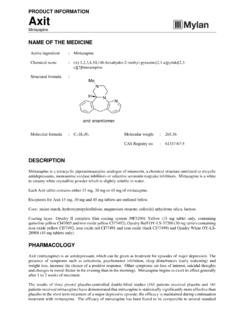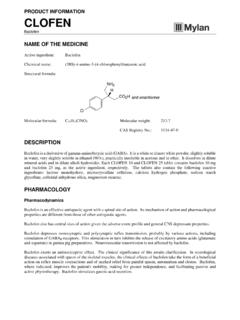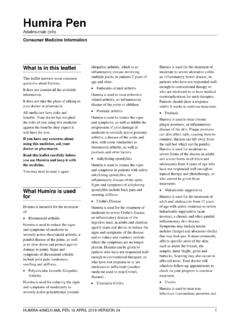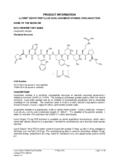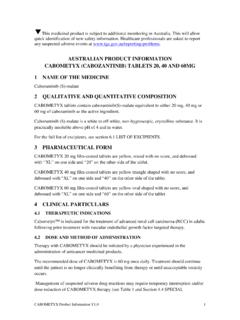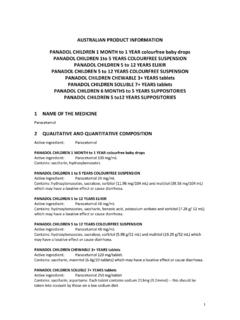Transcription of Product Information Zyrtec - Medicines
1 Zyrtec PI Page 1 of 8 Australia _____ J&J Pacific 3rd April 2014 1 of 8 Product Information Zyrtec NAME OF THE medicine cetirizine hydrochloride DESCRIPTION cetirizine hydrochloride is an orally active, H1-receptor antagonist. Chemical name: 2-(2-(4-(4-chlorophenyl) phenylmethyl)-1-piperazinyl) ethoxy) acetic acid, dihydrochloride. The molecular weight is and the chemical structure is shown below: CI HC N N CH2 C O C COOH . 2 HCl H2 H2 cetirizine hydrochloride is a white, crystalline powder and is water-soluble (160 g/100 mL). It is formulated as white, film-coated, scored 10 mg tablets, oral liquid 1 mg/mL and oral drops 10 mg/mL. PHARMACOLOGY Mechanism of action: cetirizine , a human metabolite of hydroxyzine, is an antiallergic compound; its principal effects are mediated via competitive occupancy of peripheral H1-receptors.
2 In vitro receptor binding studies have shown no measurable affinity for receptors other than H1-receptors. CNS Effects: Autoradiographic studies with radiolabelled cetirizine in the rat have shown very low penetration of the brain. Sedation was observed in animal studies, but only at doses at least 1,000 times greater than those required for antagonism of histamine H1-receptors. Studies in normal volunteers using objective measurements have, most of the time, shown no effect of cetirizine at the recommended dose of 10 mg on sleep latency time, cognitive function or motor performance. However, the occurrence of CNS effects has been observed in clinical trials in some patients (see Adverse Effects). Studies using quantitative EEG recordings and various other tests of cognitive function confirmed that cetirizine does not cause CNS depression.
3 Pharmacodynamics: Studies in normal volunteers show that cetirizine at doses of 5 and 10 mg strongly inhibits the skin wheal and flare caused by the intradermal injection of histamine. The onset of activity corresponds with the occurrence of maximal plasma levels, and significant blockade persists for at least 24 hours after a single dose. The effects of intradermal injection of various other mediators or histamine releasers are also inhibited by cetirizine , as is cold-induced urticaria. The late phase recruitment of eosinophils, a component of the allergic inflammatory response, is inhibited by cetirizine following cutaneous antigen challenge. Zyrtec PI Page 2 of 8 Australia _____ J&J Pacific 3rd April 2014 2 of 8 Pharmacokinetics: cetirizine is rapidly absorbed after oral administration.
4 In adults, peak plasma levels after a 10 mg dose are approximately 300 ng/mL and occur at about one hour. Co-administration with food decreases the rate of absorption by hour (lower Cmax and greater Tmax), but does not affect bioavailability as measured by the AUC. Plasma protein binding is 93%. The apparent volume of distribution is L/kg, suggestive of significant extravascular distribution. The plasma elimination half-life in adults is approximately 8 hours and does not change with multiple dosing. Plasma levels are proportional to the dose administered over the range of 5 to 20 mg. The bioavailability of cetirizine hydrochloride is similar from the different dosage forms of Zyrtec . The mean time taken to reach the peak serum cetirizine concentration (Tmax) was hour after a single 10 mg dose of the film coated tablets In children, as with adults, cetirizine is eliminated mostly in the urine.
5 Children over 6 years of age show peak plasma levels and times to peak similar to adults, with slightly more rapid elimination. Children younger than 6 years have more rapid clearance and a shorter half-life relative to adults. The half-life of cetirizine is approximately; 6 hours in children aged 6-12 years; 5 hours in children aged 2-6 years, and; 3 hours in infants and toddlers aged 6-24 months. In contrast to other known antihistamines, cetirizine is less extensively metabolised, and approximately 2/3 of an administered dose is excreted unchanged in the urine. This results in high bioavailability with low inter- or intrasubject variation in blood levels. A study using 14-C-labelled cetirizine showed that most of the plasma radioactivity is associated with the parent compound.
6 Only one metabolite has been identified in human plasma, the Product of oxidative dealkylation of the terminal carboxymethyl group. The antihistaminic activity of this metabolite is negligible. The total body clearance of cetirizine is reduced in subjects with renal dysfunction but below a creatinine clearance of about 30 to 50 mL/minute, little further change occurs. The pharmacokinetics of the drug was similar in patients with mild impairment (creatinine clearance higher than 40 mL/min) and normal volunteers. Moderately renally impaired patients had a 3-fold increase in half-life and 70% decrease in clearance compared to normal volunteers. Plasma levels of cetirizine are essentially unaffected by haemodialysis, and the plasma elimination half-life in dialysis patients is approximately 20 hours.
7 The plasma AUC is increased about threefold in these patients. The clearance of cetirizine is reduced in elderly patients, but only in proportion to the decrease in creatinine clearance. Thus, in 16 patients with a mean age of 77 years, half-life increased to 12 hours. cetirizine blood levels were monitored in a clinical trial of 59 patients, aged 60 to 82, who received 10 mg of cetirizine daily for three weeks, and no undue accumulation of cetirizine was found. INDICATIONS Seasonal allergic rhinitis: cetirizine is indicated for the relief of symptoms associated with seasonal allergic rhinitis (hay fever) in adults and children aged 1-12 years. Symptoms treated effectively include sneezing, rhinorrhoea, post-nasal discharge, nasal pruritus, ocular pruritus and tearing and redness of the eyes.
8 Perennial allergic rhinitis: cetirizine is indicated for the relief of symptoms associated with perennial allergic rhinitis in adults and children aged 1-12 years. Symptoms treated effectively include sneezing, rhinorrhoea, post-nasal discharge, nasal pruritus, ocular pruritus and tearing. Chronic idiopathic urticaria: cetirizine is indicated for the treatment of the uncomplicated skin manifestations of chronic idiopathic urticaria in adults and children aged 1-12 years. It significantly reduces the occurrence, severity and duration of hives and markedly reduces pruritus. As with other antihistamines, patients should be advised to seek medical advice about the possibility that their urticaria is associated with ingestion of certain foods.
9 Zyrtec PI Page 3 of 8 Australia _____ J&J Pacific 3rd April 2014 3 of 8 CONTRAINDICATIONS Zyrtec ( cetirizine hydrochloride) is contraindicated: - in patients with a known hypersensitivity to any of the ingredients of the Zyrtec formulations (see under PRESENTATION) - in patients with a known hypersensitivity to hydroxyzine (the parent compound of cetirizine ) or to any piperazine derivatives - in patients with severe renal impairment (less than 10 mL/min creatinine clearance) Patients with rare hereditary problems of galactose intolerance, the Lapp lactase deficiency or glucose- galactose malabsorption should not take Zyrtec film-coated tablets. Patients with rare hereditary problems of fructose intolerance should not take Zyrtec 1 mg/mL oral liquid.
10 PRECAUTIONS Although it has been shown that cetirizine at the recommended dose of 10 mg does not potentiate the effect of alcohol, in sensitive patients, the simultaneous administration of cetirizine and alcohol or other CNS depressants may have effects on the CNS. Therefore, precaution is recommended if alcohol is taken concomitantly. Activities requiring mental alertness: Some patients may experience a degree of drowsiness with cetirizine . Studies using objective measurements have shown no effect of cetirizine on cognitive function, motor performance of sleep latency. However, in clinical trials, the occurrence of CNS effects has been observed in some individual patients and due caution should be exercised when driving a car or operating potentially dangerous machinery.
